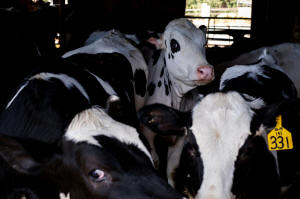Bird flu strain in US cows shows minimal air spread in ferret study
 Send a link to a friend
Send a link to a friend
 [July 09, 2024]
By Jennifer Rigby [July 09, 2024]
By Jennifer Rigby
LONDON (Reuters) -The bird flu strain found in cows in the United States
is not easily transmitted through the air among ferrets, a new study
shows, although the scientist who led the work said it had shown some
ability to spread this way.
Ferrets are considered to be the best small mammal for studying
influenza virus infection and transmission, and are often used to inform
assessments of the public health risks of emerging viruses.
In the experiment led by researchers at the University of
Wisconsin-Madison, ferrets infected with a sample of the H5N1 bird flu
strain were placed near healthy animals, but not close enough for
physical contact.
None of the four healthy ferrets exposed in this way became ill and no
virus was recovered from them during the study.
However, one of the ferrets produced antibodies to the virus, the
researchers later found, suggesting it had been infected.
"It is good news that the virus does not have extensive transmissibility
between ferrets through the air, but it is concerning that it has the
ability to transmit (at all in this way)," said study author and flu
virologist Yoshihiro Kawaoka.
A virus that can spread easily through the air between humans would pose
a greater pandemic threat than H5N1 currently does.
That risk is assessed by public health agencies worldwide as low, as
there is no evidence of any human-to-human transmission.
Four human cases, all dairy workers, have been reported in the U.S.
since avian flu was confirmed in dairy cows in March. All four people
have recovered.
The study, published on Monday in Nature, also showed the bird flu virus
in cows can bind to human-type receptors under lab conditions. These
receptors are how flu viruses typically enter and infect human cells in
the real world.

[to top of second column]
|

Cows stand in their pen at a cattle farm in Rockford, Illinois,
U.S., April 9, 2024. REUTERS/Jim Vondruska/File Photo
 Bird flu prefers to bind to
avian-type receptors only, which are scarce in humans. The lab
results need further study to assess their real-world implications,
scientists said, as in the past flu viruses that developed the
ability to bind to both types have caused human pandemics.
Scientists have so far suspected the virus spreads among animals and
humans through contact with infected milk or aerosolized milk
droplets, or from exposure to infected birds or poultry.
The study also confirmed that the virus, isolated from the milk of
an infected cow in New Mexico, made both mice and ferrets sick after
exposure to the unpasteurized milk.
It also spread through the body to muscles and mammary glands in
infected mice, as it appears to do in cows.
Angela Rasmussen, a virologist at the University of Saskatchewan in
Canada, said it was a relief to see the virus had not yet acquired
the capability to cause a human pandemic, but this did not mean it
would never do so, particularly if the spread among cows goes
unchecked.
"It's always better to stop a pandemic before it starts than to
respond to it once it has started. We should heed this warning and
take action now," she said via email.
The study was funded by the National Institute of Allergy and
Infectious Diseases (NIAID), part of the National Institutes of
Health in the U.S.
(Reporting by Jennifer Rigby; Editing by Jan Harvey and Rod Nickel)
[© 2024 Thomson Reuters. All rights reserved.]This material may not be published,
broadcast, rewritten or redistributed.
Thompson Reuters is solely responsible for this content. |